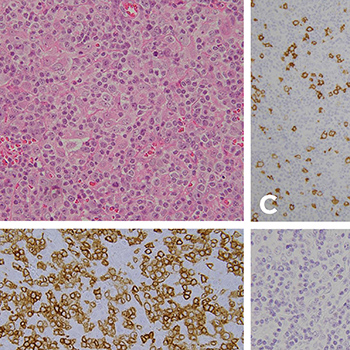Keywords
Adrenal mass, diffuse large B-cell lymphoma, Epstein-Barr virus, angioimmunoblastic T-cell lymphoma
Abstract
Angioimmunoblastic T-cell lymphoma (AITL) can be complicated by Epstein-Barr virus (EBV)-positive B-cell lymphoma. B-cell lymphoma may develop simultaneously at the time of AITL diagnosis or after treatment for AITL. EBV-associated B-cell lymphoma can occur in nodal and extranodal sites. We report a case of EBV-positive diffuse large B-cell lymphoma (DLBCL) of the left adrenal gland that developed after treatment for AITL.
The patient presented with systemic lymphadenopathy and biopsy of one lymph node showed AITL. A complete response (CR) was achieved after initial chemotherapy for AITL, but 9 months later the left adrenal gland was enlarged. The diagnosis of EBV-positive DLBCL was made based on the histopathological findings of the left adrenal gland biopsy. Thus, EBV-positive DLBCL developed after AITL CR was achieved. Multi-drug chemotherapy combined with rituximab was administered for adrenal DLBCL, but only a partial response was achieved.
We confirmed that EBV-positive B-cell lymphoma developed after treatment for AITL. An adrenal primary is rare, and this is only the second case of EBV-positive B-cell lymphoma to be reported after treatment for AITL. Clinicians should keep in mind that when nodal and extranodal lesions are seen after AITL treatment, another biopsy should be performed for the accurate determination of whether these lesions indicate AITL relapse or new-onset EBV-positive B-cell lymphoma.
References

Views: 533
HTML downloads: 86
PDF downloads: 306
Published:
2021-10-27
Issue:
2021: Vol 8 No 10
(view)










